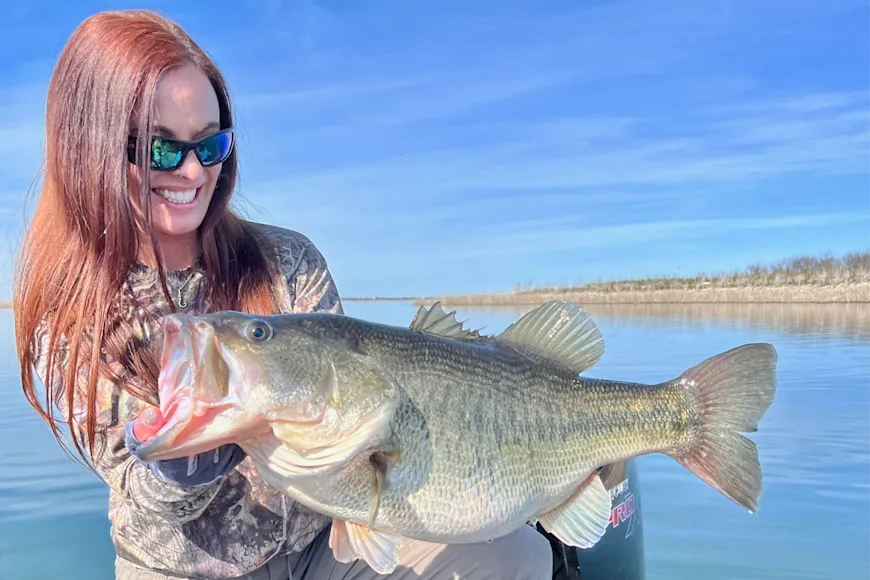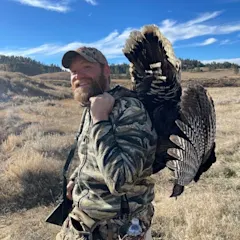Back in February 2023, tournament angler Lea Anne Powell hooked into a once-in-a-lifetime largemouth on Texas' O.H. Ivie Lake while fishing a Damiki Rig through flooded timber with guide and fellow big bass enthusiast Dalton Smith. After an intense fight, Powell boated the behemoth, and the two anglers set off to get it weighed on the nearest certified scale.
The fish weighed a whopping 12 pounds, 3 ounces, making it a legitimate lunker, even on O.H. Ivie, where big bass are a dime a dozen. But it wasn't until several months later that Powell realized it might be a contender for a new International Game Fish Association line class world record.
“I was at the Bassmaster Classic in Knoxville, and I told a friend of mine about the fish and showed him some pictures,” Powell told Field & Stream, at the time. “He said, ‘You should get that fish certified.'” Powell decided to take the advice. She submitted a comprehensive list of the required information to the IGFA and sent them a 20-foot section of the 10-pound test line she was using when she caught the fish. On June 23, her bass was certified as the new world record for the 12-pound line class in the women’s category.
Powell gets back to O.H. Ivie to chase largemouth every chance she gets, she tells F&S, and she travels widely across the country in pursuit of everything from bonita to big bull red drums. When it comes to bass lakes, though, she's got a few favorites. We caught up with her to find out what those favorites are so that you know where to head next.
1. O.H. Ivie
Smack dab in the heart of Texas, O.H. Ivie is a reservoir fed by the Colorado and Concho Rivers. It spans three counties—Coleman, Concho, and Runnels—and it sits about three hours southwest of Fort Worth. Powell calls the lake her "favorite body of water bar none," and it's easy to see why. In recent years, O.H. Ivie has become the hottest bass fishing destination in the country, with B.A.S.S. naming it the nation's best as recently as 2023. In addition to Powell's current line-class world record, O.H. Ivie produced the 7th and 8th place rankings for the biggest bass ever caught in Texas, weighing 16.9 pounds and 17.03 pounds respectively.
2. Eufaula Lake
With some 600 miles of shoreline along the Georigia-Alabma line, Eufaula draws trophy bass hunters from all over the United States. It's a popular destination on the tournament circuit and has been a proving ground for many a pro-angler over the years. Not to be confused with Oklahoma's Eufaula (a great bass fishery in its own right), this southeastern impoundment is best fished in March—if you're looking for shallow water lunkers. According to Powell, "if you enjoy frogging, punching, and pitching," then Eufaula is the lake for you.
3. Sam Rayburn Reservoir
O.H. Ivie isn't the only Texas lake on Powell's list. Sam Rayburn Reservoir, she says, is another must-visit bass fishing destination. "I love this lake because of the vegetation variety it produces," Powell says. "It has both East and West Coast styles of fishing, and it consistently produces large fish. There’s a reason the Big Bass Splash is held out of here."
4. Toledo Bend Reservoir
Powell has an obvious affinity for Texas bass fishing, and the Toledo Bend Reservoir is another Lone-Star State gem on her top-ten list. Situated in the far-eastern part of the state, on the Louisiana border, Toldeo Bend is a 186,000-acre bass factory known of 10-plus pound largemouths. According to Texas Parks, and Wildlife, the bass fishing on Toledo Bend is good year round. Hotspots along the lake include Indian Mounds, Housen Bay (known for its spawning coves), Pendelton Bridge, and Negreet Creek.
5. St. Johns River
The St. Johns River is the longest-flowing river in Florida, meandering some 300 miles from its mouth at Blue Cypress Lake before emptying into the Atlantic Ocean just east of Jacksonville. The river is fishable year round, but the dry season (later summer to early spring) is the best time to target largemouth bass. Powell likes to flip jigs and small swimbaits to the hard-fighting fish that tend to congregate in the Cypress.
6. Pickwick Lake
Pickwick Lake is 43,000-acre reservoir impounded by the Tennessee Vally Authority in 1935. It spans three states—Alabama, Tennessee, and Mississippi—and is one of the best smallmouth bass fisheries in the entire Southeast. Smallmouth in the five- to eight-pound range aren't uncommon in Pickwick, but the lake is also known for its lunker largemouth: in 2012 an angler landed a state-record contender weighing 14.5 pounds.
7. Lake Lanier
Lake Lanier is a 38,000-acre lake in the rolling north Georgia mountains that's fed by the Chattahoochee and Chetastee Rivers. It's the place Powell goes to when she wants to catch a boat full of spotted bass. "It's one of the best spotted bass lakes in the country in my opinion," she says, adding that the spotties will rise from a depth of 60-plus feet just to smash a sub-surface swimbait.
8. Clear Lake
California's Clear Lake has been called the "Bass Capital of the West", and for good reason. The lakes biggest-known largemouth, caught in 1990, weighed an insane 17.5 pounds. The largest naturally occurring lake in California, Clear Lake has been stocked with famous Florida-strain largemouths since the 1950s. Bass anglers like to hit this lake from March to May, when the those Florida-strain giants move into the shallows to spawn.
Read Next: Best Bass Fishing Lakes in Texas
9. Berryessa
Berryessa is another California destination on Powell's list that's known for next-level largemouth bass fishing. Like Clear Lake, the standing record on Berryessa weighed in at a whopping 17 pounds, and the biggest bass are all Florida-strain transplants. Concentrate on the shallows during the warmer months on Berryessa, then head for the deeper waters—like those found in Markley Cove—when the temperature starts to drop.
10. Lake Okeechobee
Powell calls Lake Okeechobee's well-known status as Bass Capitol of the United States "self explanatory." Like other Florida bass fisheries, the bassing is good year round on Okeechobee. But the best times for big fish on the "Big O" happen between November and June. The lake itself is so massive (some 450,000 acres) that it can be seen on a satellite images of earth, and the largemouth here have adapted to their giant surroundings. They average seven to ten pounds but rarely exceed 12 pounds. The all-time lake record weighed 15 pounds, 5 ounces, according to the Army Corps of Engineers.


